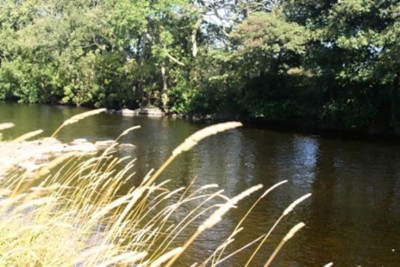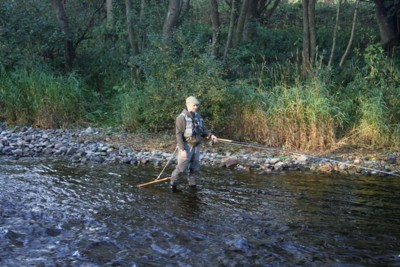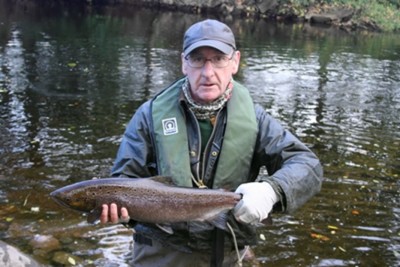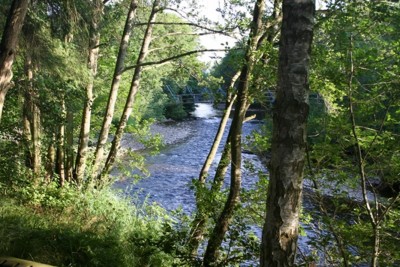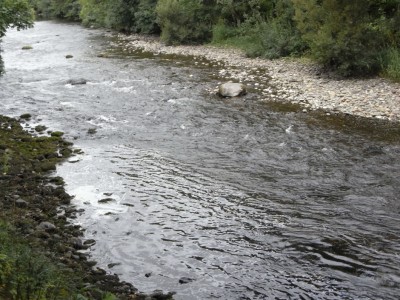These bulletin blogs represent news about Finavon and the South Esk, and my views as a riparian owner. While I may digress at times to write about other places, these are not the views of any other organisation, nor are they designed to promote the interests of any individual or organisation other than Finavon Castle Water and factors affecting the fishery. Tony Andrews
As we move into the last three weeks of the 2013 season it only takes a glance at the SEPA graphs of water levels in the South Esk since May to realise that this summer has been a dry one. In fact it has been the driest for more than 30 years.
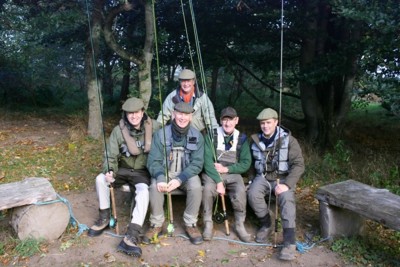
October fishing party at FCW.
Sitting L>R: Mathew Brown, James Horne, Peter Bentley, Oliver Reeve
Behind them their guide, John Wood.
It is therefore not surprising that fish have been hard to catch. They have also been hard to see, except in bright sunshine when their shadows and shapes were discernible against the pale tones of the river bed gravel. The truth is that there have been reasonable numbers of both salmon and sea trout throughout the four and a half months of mainly low water levels. In a previous blog I wrote about a July visit by Colin Gibb and myself to the Boat Pool where we observed hundreds of sea trout lying doggo in the main dub of the pool. Since then there has been a constant changing of the guard as fish moved into the lies immediately downstream of the Haughs Aqueduct, and then moved on – to be replaced by another group of fish, a mixture of grilse and MSW salmon, interspersed with diminishing numbers of sea trout as the autumn advanced.
Talking of sea trout, it is good to see a lot of spawning activity in Willows and the glide above Volcano, where more than 40 redds can be seen. Those two locations have long been favoured spawning beds for our sea trout, and it is encouraging to see a good level of regeneration continuing.
We had a small freshet last weekend which washed away some of the algae and accumulated debris in the margins of the river, but it brought very few fresh salmon into the river. It was more a juggling of what was already in the river than an introduction of newly arrived salmon. But that changed yesterday (Friday) with Peter Bentley catching a 6lbs silvery cock grilse from Beeches on Castle Beat, having caught and returned a 6lbs grilse in Volcano on Thursday and another one of the same size, also in Beeches. Peter is a skilled angler who fishes quietly and accurately, and catches fish as a result.
So there are fish about, not in great numbers but they are there. A feature of fish behaviour this year has been how seldom fish have shown by breaking the surface. We have had to search for them using Polaroid glasses and peering into the pools in daylight. There have been occasional flurries of fish showing, but generally these have only been for a few minutes, perhaps prompted by subtle changes in atmospheric pressure.
As write this on Saturday the 12th of October the FCW total of salmon and grilse for the 2013 season stands at 40 and sea trout at a paltry 24. It has not been a good fishing season. There have been weeks on end when effort has dropped away to extremely low levels, with some weeks of zero effort. Never mind; I keep saying to myself that such summer weather is not unusual, or at least it used not to be so. Perhaps we have been lulled into thinking that every summer is guaranteed to be as wet as the last five have been. My memory doesn’t need much jogging to recall a number of dry summers, although none as extensively so as this one. We just need to remember that we are dealing with wild species in a natural resource influenced by a varying climate. Nothing new in that.
I shall write soon about the importance of measuring fishing effort in the context of our use of catch returns as a measure of abundance. On a small river such as the South Esk, which, when the water level is low, is a clear water stream, effort is more than simply counting up the number of rod days. We need to draw in a number of other factors, including angling method, skill level of the angler, local knowledge, the time of year and hours spent on the river. Whatever formula we eventually reach cannot be any more than an impression of effort, but at least it might indicate a trend…
TA 13/10/2013
